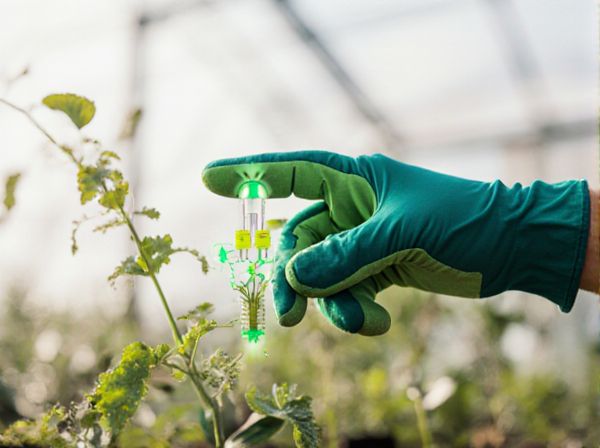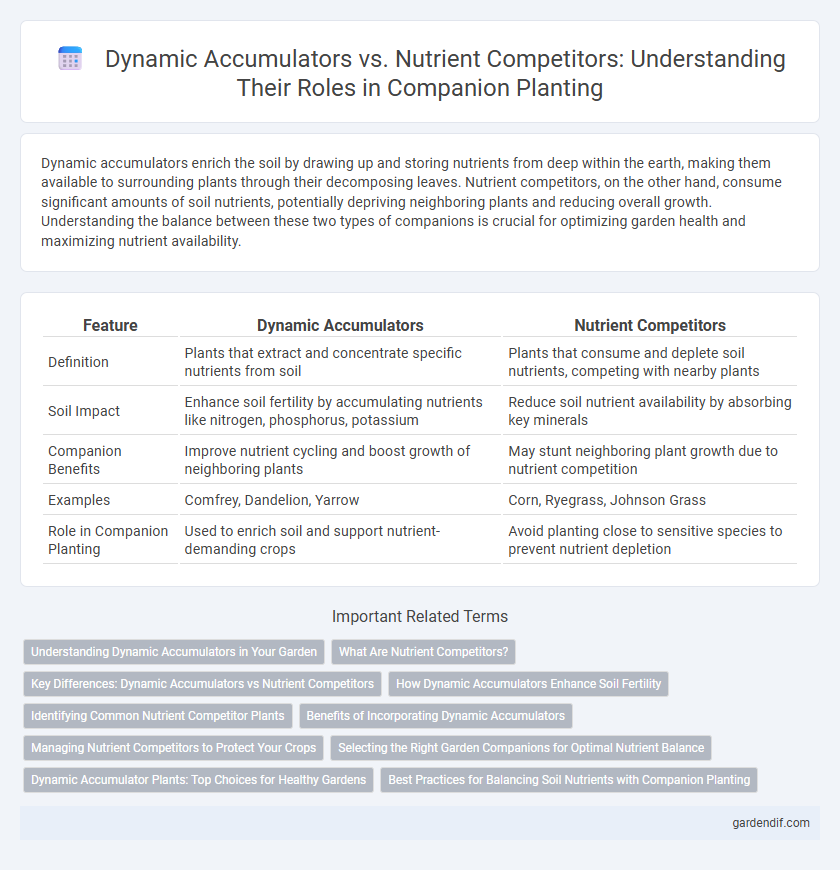
Dynamic accumulators vs nutrient competitors Illustration
Dynamic accumulators enrich the soil by drawing up and storing nutrients from deep within the earth, making them available to surrounding plants through their decomposing leaves. Nutrient competitors, on the other hand, consume significant amounts of soil nutrients, potentially depriving neighboring plants and reducing overall growth. Understanding the balance between these two types of companions is crucial for optimizing garden health and maximizing nutrient availability.
Table of Comparison
| Feature | Dynamic Accumulators | Nutrient Competitors |
|---|---|---|
| Definition | Plants that extract and concentrate specific nutrients from soil | Plants that consume and deplete soil nutrients, competing with nearby plants |
| Soil Impact | Enhance soil fertility by accumulating nutrients like nitrogen, phosphorus, potassium | Reduce soil nutrient availability by absorbing key minerals |
| Companion Benefits | Improve nutrient cycling and boost growth of neighboring plants | May stunt neighboring plant growth due to nutrient competition |
| Examples | Comfrey, Dandelion, Yarrow | Corn, Ryegrass, Johnson Grass |
| Role in Companion Planting | Used to enrich soil and support nutrient-demanding crops | Avoid planting close to sensitive species to prevent nutrient depletion |
Understanding Dynamic Accumulators in Your Garden
Dynamic accumulators are plants that absorb and concentrate specific nutrients from the soil, enhancing garden fertility by making these nutrients more available to other plants. Unlike nutrient competitors, which deplete soil resources, dynamic accumulators contribute essential elements like nitrogen, phosphorus, and potassium, improving soil health and plant growth. Recognizing and integrating these plants into your garden ecosystem supports sustainable nutrient cycling and reduces the need for synthetic fertilizers.
What Are Nutrient Competitors?
Nutrient competitors are plants that aggressively absorb soil nutrients, often depleting resources essential for nearby crops or companions. These species typically have extensive root systems or high nutrient demands, leading to reduced availability of nitrogen, phosphorus, and potassium for neighboring plants. Understanding the behavior of nutrient competitors helps gardeners select appropriate companions that promote balanced nutrient uptake and optimal growth.
Key Differences: Dynamic Accumulators vs Nutrient Competitors
Dynamic accumulators are plants that absorb and concentrate specific nutrients from the soil, making them accessible to other plants when their biomass decomposes, whereas nutrient competitors extract similar nutrients from the soil, potentially depleting resources for nearby plants. Key differences include nutrient cycling roles, with dynamic accumulators enhancing soil fertility by recycling minerals like potassium and calcium, while nutrient competitors primarily compete for nitrogen, phosphorus, and other essential nutrients. This distinction impacts companion planting strategies by selecting dynamic accumulators to improve soil health and nutrient availability, contrasting with nutrient competitors that can reduce overall yield through resource competition.
How Dynamic Accumulators Enhance Soil Fertility
Dynamic accumulators like comfrey and nettle concentrate essential nutrients such as potassium, calcium, and nitrogen from deep within the soil, making them more accessible to surrounding plants. Their deep root systems break up compacted soil layers, improving aeration and water infiltration while cycling vital minerals to the surface. Utilizing dynamic accumulators in companion planting accelerates nutrient recycling, enhancing soil fertility without depleting resources like nutrient competitors often do.
Identifying Common Nutrient Competitor Plants
Dynamic accumulators such as comfrey, nettle, and dandelion enhance soil nutrient availability by mining and concentrating essential minerals like potassium, calcium, and nitrogen, unlike common nutrient competitor plants that deplete soil resources. Identifying nutrient competitors such as chickweed, crabgrass, and bindweed is crucial since these species aggressively consume nitrogen and phosphorus, reducing fertility for companion plants. Proper selection and management of companions prevent nutrient competition, promoting a more balanced and productive garden ecosystem.
Benefits of Incorporating Dynamic Accumulators
Dynamic accumulators enhance soil fertility by extracting and storing vital nutrients such as potassium, calcium, and magnesium, making them readily available for companion plants. Their deep root systems improve soil aeration and structure, facilitating better water retention and nutrient uptake for neighboring crops. Incorporating dynamic accumulators reduces reliance on synthetic fertilizers, promoting sustainable and resilient garden ecosystems.
Managing Nutrient Competitors to Protect Your Crops
Managing nutrient competitors is essential to protect your crops by minimizing soil nutrient depletion caused by dynamic accumulators. Dynamic accumulators enhance soil fertility by absorbing and recycling key nutrients such as nitrogen, phosphorus, and potassium, which can otherwise be consumed rapidly by nutrient competitors like invasive weeds. Strategic use of companion plants that function as dynamic accumulators reduces competition, improves nutrient availability, and promotes healthier crop growth.
Selecting the Right Garden Companions for Optimal Nutrient Balance
Choosing the right garden companions involves balancing dynamic accumulators, which draw up deep soil nutrients, against nutrient competitors that deplete essential resources. Dynamic accumulators like comfrey and yarrow enhance soil fertility by concentrating minerals such as potassium and calcium near the surface. Selecting companions that complement rather than compete ensures optimal nutrient availability and promotes healthier plant growth.
Dynamic Accumulator Plants: Top Choices for Healthy Gardens
Dynamic accumulator plants, such as comfrey, nettle, and dandelion, play a crucial role in enriching garden soil by drawing up essential nutrients like potassium, calcium, and nitrogen from deep within the earth. These plants improve soil fertility and structure, promoting healthier companion planting and reducing the need for chemical fertilizers. Using dynamic accumulators strategically supports nutrient cycling and vitality, distinctly benefiting gardens plagued by nutrient competitors that deplete topsoil resources.
Best Practices for Balancing Soil Nutrients with Companion Planting
Dynamic accumulators like comfrey and nettle absorb deep soil nutrients and release them in accessible forms, enriching the soil naturally and reducing the need for synthetic fertilizers. Pairing these plants with nutrient competitors such as corn or beans requires strategic spacing and staggering growth cycles to prevent resource depletion and promote nutrient cycling. Implementing best practices involves monitoring soil nutrient levels regularly, choosing complementary species with differing root depths, and utilizing organic mulches to maintain balanced soil fertility in companion planting systems.
Dynamic accumulators vs nutrient competitors Infographic

 gardendif.com
gardendif.com